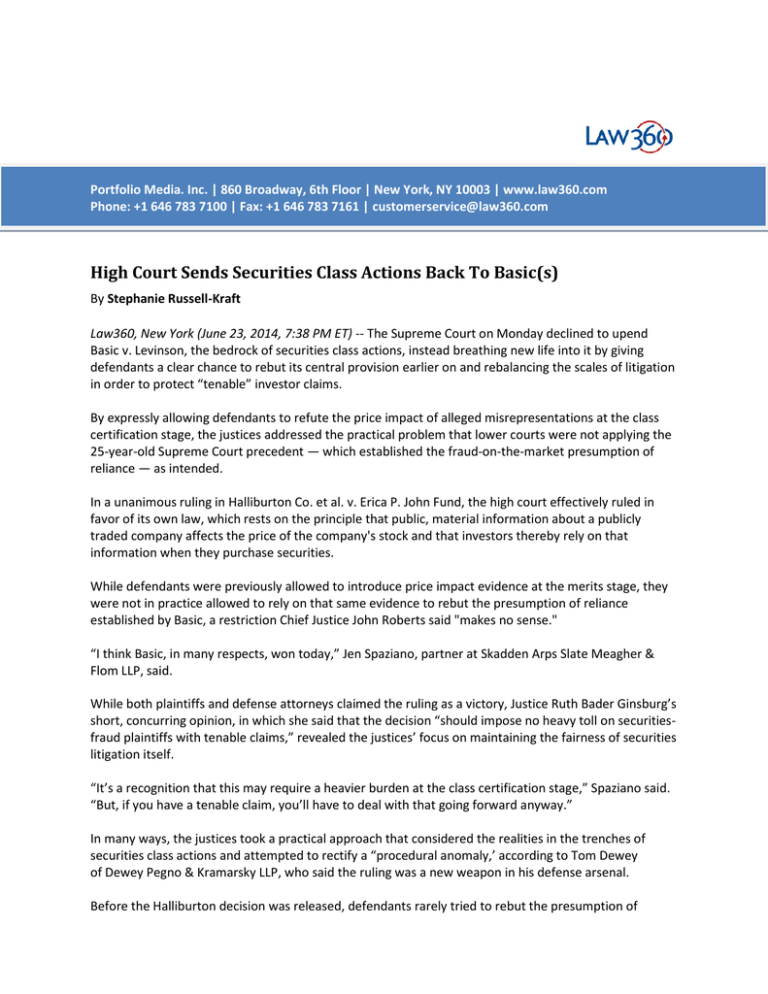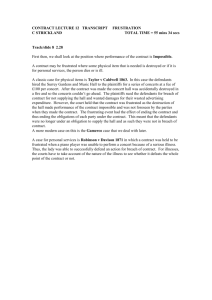Portfolio Media. Inc. | 860 Broadway, 6th Floor | New...
advertisement

Portfolio Media. Inc. | 860 Broadway, 6th Floor | New York, NY 10003 | www.law360.com Phone: +1 646 783 7100 | Fax: +1 646 783 7161 | customerservice@law360.com High Court Sends Securities Class Actions Back To Basic(s) By Stephanie Russell-Kraft Law360, New York (June 23, 2014, 7:38 PM ET) -- The Supreme Court on Monday declined to upend Basic v. Levinson, the bedrock of securities class actions, instead breathing new life into it by giving defendants a clear chance to rebut its central provision earlier on and rebalancing the scales of litigation in order to protect “tenable” investor claims. By expressly allowing defendants to refute the price impact of alleged misrepresentations at the class certification stage, the justices addressed the practical problem that lower courts were not applying the 25-year-old Supreme Court precedent — which established the fraud-on-the-market presumption of reliance — as intended. In a unanimous ruling in Halliburton Co. et al. v. Erica P. John Fund, the high court effectively ruled in favor of its own law, which rests on the principle that public, material information about a publicly traded company affects the price of the company's stock and that investors thereby rely on that information when they purchase securities. While defendants were previously allowed to introduce price impact evidence at the merits stage, they were not in practice allowed to rely on that same evidence to rebut the presumption of reliance established by Basic, a restriction Chief Justice John Roberts said "makes no sense." “I think Basic, in many respects, won today,” Jen Spaziano, partner at Skadden Arps Slate Meagher & Flom LLP, said. While both plaintiffs and defense attorneys claimed the ruling as a victory, Justice Ruth Bader Ginsburg’s short, concurring opinion, in which she said that the decision “should impose no heavy toll on securitiesfraud plaintiffs with tenable claims,” revealed the justices’ focus on maintaining the fairness of securities litigation itself. “It’s a recognition that this may require a heavier burden at the class certification stage,” Spaziano said. “But, if you have a tenable claim, you’ll have to deal with that going forward anyway.” In many ways, the justices took a practical approach that considered the realities in the trenches of securities class actions and attempted to rectify a “procedural anomaly,’ according to Tom Dewey of Dewey Pegno & Kramarsky LLP, who said the ruling was a new weapon in his defense arsenal. Before the Halliburton decision was released, defendants rarely tried to rebut the presumption of reliance because it was generally considered to be “irrebuttable,” according to Jordan Eth of Morrison & Foerster LLP. But now, said Ropes & Gray LLP partner John Donovan: “The court has said, ‘We’re not only going to maintain the Basic framework, we’re going to breathe life into it. If you should be able to rebut it, let’s make it rebuttable.'” Most defense attorneys said the high court’s decision gave them a new weapon, but many disagreed on its size, strength and ultimate utility. Baker Botts, which represented Halliburton in the Supreme Court bid, has argued that many cases have been allowed to proceed past class certification despite a lack of proof that a company’s alleged misstatement distorted its stock price. The firm said Monday that the high court’s ruling would allow lower courts to “weed out meritless cases” before the important milestone of class certification and limit plaintiffs attorneys’ ability to “extort” settlements later on. Other attorneys, including Donovan and Bruce D. Angiolillo of Simpson Thacher & Bartlett LLP, said they expect the impact of the court’s decision to “stay at the margins” and have little impact on the defense bar’s ability to litigate claims. The plaintiffs bar on Monday heralded the court’s ruling as a victory, breathing a sigh of relief that a doomsday scenario — the overturning of Basic — was avoided. Larry Sucharow of Labaton & Sucharow LLP welcomed the ruling with a smile, saying it reaffirmed Basic’s “tremendous vitality” without threatening class actions. The cases that are strong on the merits will survive no matter what, whether they are tested at the class certification stage or later on, he said. “It’s hard to see this as anything other than a very strong decision on the plaintiffs’ side,” said Sal Graziano, a partner at Bernstein Litowitz Berger & Grossmann LLP. Still, some critics contended that the court did not go far enough toward leveling the playing field by leaving on defendants the burden of proving price impact. By allowing plaintiffs to escape that first hurdle, the justices did nothing to limit the number of cases filed while potentially increasing the costs of securities litigation, according to Adam Pritchard, a University of Michigan law professor who cowrote a much-cited amicus brief known as the law professors brief. Moving price impact analysis to an earlier stage in litigation is likely to increase costs for both plaintiffs and defendants, but for some defendants, that may be a gamble they’re willing to take. “Once a court certifies a case to go forward as a class action, the sheer size of the certified class can place enormous pressure on a company to settle even a frivolous case,” Mark Haddad of Sidley Austin LLP said. For the few defendants who foresee a reasonable chance of defeating class certification, the cost of a full price impact analysis will still likely be lower than the cost — or risk — of a large settlement later on, attorneys say. Under the high court’s Halliburton decision, they now have the real ability to take that financial and tactical risk. While the ruling may only concern a small subset of securities class actions — those SEC Rule 10b-5 cases where price impact is disputed — it will streamline the practical application of Basic, according to Doug Greene of Lane Powell PC. “The court’s decision will result in more meaningful class certification litigation, even if it ultimately doesn’t result in a greater number of cases being dismissed,” he said. --Editing by Kat Laskowski and Chris Yates. All Content © 2003-2014, Portfolio Media, Inc.

